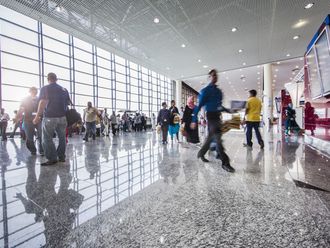Tokyo: Daisuke Horii just collected his summer bonus. It was only slightly more than last year, but enough to compel the 34-year-old shopping mall clerk to Tokyo’s electronics district to look for some high-end speakers.
“Things are generally looking brighter, aren’t they?” Horii said, as he scrutinised, then dismissed, cheaper alternatives at the bustling Yodobashi Camera electronics store. The Bose ones he has his eye on, which he’ll hook up to his TV, go for about $400 (Dh1,469).
“I don’t really need it, but I want it,” he said. “A good economy means you can buy things you don’t really need.”
Prime Minister Shinzo Abe’s bid to revive Japan’s deflated economy hinges on consumers like Horii starting to feel flush enough to start splurging on the finer things in life.
A wide recovery in consumer spending has been the weakest link in “Abenomics,” the bold economic stimulus strategy that Abe has pushed since taking office in late December.
Abenomics has already brought big profit bumps to the nation’s exporters, thanks to a yen made weaker by Abe’s aggressive policies. He found a kindred spirit in Haruhiko Kuroda, the Bank of Japan’s new governor, who has committed the central bank to easing the money supply and reinflating the economy. Stock markets have rallied, as foreign investors jumped back into a country they had all but written off for its seemingly unshakable stagnation.
Numbers released on Friday by the government provided more proof of Japan’s corporate recovery. Industrial production rose by a robust two per cent in May from the previous month. Tokyo’s benchmark Nikkei index climbed 3.5 per cent on Friday on the strong showing.
Reversing a 15-year-long slide in prices, which Abe has singled out as both a cause and a symptom of waning profits, wages and consumption, is a tougher order. For companies to feel confident enough to start raising prices, Japan’s consumers have to start spending again, and data confirming that trend is still mixed.
Separate figures released Friday showed that household spending fell 1.6 per cent in May from a year earlier, confounding economists’ expectations of a 1.3 per cent rise. Still, for the first time in seven months, Japan’s core consumer prices in May did not fall compared to the previous year, staying flat for that month after falling 0.4 per cent the previous month.
“We are comfortable with our view that the uptrend of consumption continues,” Masamichi Adachi, Tokyo-based economist at JPMorgan Securities Japan, said in a note Friday. “An expected rise in summer bonuses, paid in June and July, and improvement in general sentiment are the main reasons,” he said.
There are some signs that after years of penny-pinching, conspicuous spending is on the rise again in Japan. But for now, it is starting at the very top, among the financiers, professionals and other well-to-do Japanese who have benefited from the recent stock market gains.
Sales of Ferrari cars in Japan have jumped almost 20 per cent so far this year, figures from the Japan Automobile Importers Association show, thanks to this newfound exuberance among the nation’s rich.
“We’ve seen confidence start to explode over the last months,” said Herbert Appleroth, chief executive of Ferrari Japan. “We’re seeing some of the highest growth in the world here.”
At the Hankyu Umeda department store in Osaka, sales of luxury watches, jewellery and other luxury items are surging, which lifted overall sales in May by 63 per cent compared with the previous year, the sixth straight month of double-digit increases.
“Japanese shoppers are tired of cheap,” said Keiji Uchiyama, manager of the marble-floored store, brimming with imported fragrances, pastel macaroons and slick designer bags. “They’ve scrimped for so long, but now they’ve had enough,” he said.
Nobuko Kido, 61, and Ikuko Hatanaka, 60, both full-time homemakers, said that the recent positive media coverage of the economy alone made them less guilty about splurging at the department store. Kido had just spent 60,000 yen ($612) on a small handbag from the Italian luxury fashion house Etro.
“There’s a feeling that the economy is finally picking up,” said Kido, whose husband is a trading company executive. “Or maybe it’s just an excuse I will tell my husband.”
It is a striking return to form for Japan’s consumers, known for their profligate spending in the bubble years of the 1980s. But Japanese consumers hunkered down in the 1990s and in this decade as they adjusted to a deflationary economy and dire expectations for future growth. Patrons of department stores like Hankyu Umeda, once the epitome of luxury and good living, ditched its polished boutiques and headed to discount stores.
As deflation became entrenched, consumers adjusted accordingly. Instead of splurging on a bottle of Chanel fragrance, they started to buy perfume by the gram from peddlers online. Companies adjusted, and designer denims gave way to no-frill jeans that went for $10 instead of $100. Consumers began visiting Japan’s ubiquitous 100-yen shops, Don Quijote discount stores or even the Hard-Off recycled merchandise stores.
Consumers grew accustomed to expecting that the longer they waited, the cheaper goods would become. And they held back on spending. That led to even less demand and more years of deflation.
The challenge for Abe has been to reverse those entrenched expectations. For now, he is helped by a weak yen, which inflates the price of imported products. And enthusiasm over signs of life in the stock market, as well as over expectations for a recovery, are lifting spirits.
Economists say much hangs on how much corporate profit will eventually find its way to consumers in the form of higher wages and better job opportunities. Jobs data released Friday, however, showed the nation’s official unemployment rate in April unchanged, at 4.1 per cent.
“Unless we see an improvement in the demand gap, companies aren’t going to change their pricing or pay habits,” Ryutaro Kono and Azusa Kato, economists at BNP Paribas in Tokyo, wrote in a note.
There is a big risk in the re-inflation strategy. If prices start rising merely on the back of the weaker yen with no wage increases, households could feel the squeeze. “Then there could be a strong backlash,” the two economists wrote.
For younger Japanese, living frugally has become a way of life. Shinsuke Nagata, 34, and his girlfriend, Yoko Sutani, 29, came to window-shop at Hankyu Umeda, but ended up buying only $4 coffees at a stand in the store’s atrium.
“All this talk of Abenomics doesn’t really apply to us yet. Hopefully it doesn’t just stop with the rich people,” said Nagata, who is a freelance graphic designer.
“I wouldn’t buy clothes here. It’s too expensive. I usually go to Uniqlo,” said Sutani, a yoga instructor, referring to the inexpensive clothing store chain.
Some retailers seem confused as to whether to cater to the Kidos of Japan, willing to spend a little extra, or the Nagatas, still scrimping on the pennies.
Kozo Sushi, a nationwide takeout sushi chain, said this week it was lowering prices at the cheaper end of its menu to 399 yen ($4), but would add a new superpremium meal, which costs 1,189 yen ($12) and comes with more delicacies.
“Abenomics is benefiting only the lucky few, so we didn’t want anyone to feel left out,” said Akira Tashima, a Kozo Sushi spokesman. “If you’re one of the lucky ones, we have snow crab for you. If you need to save, we also have plain tuna.”











